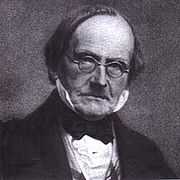Jean de Charpentier

Jean de Charpentier or Johann von Charpentier (8 December 1786 – 12 December 1855) was a German-Swiss geologist who studied Swiss glaciers. He was born in Freiberg, Saxony, Germany and died in Bex, Switzerland.
After following in his father's footsteps as a mining engineer he excelled in his field while working in the copper mines in the Pyrénées and salt mines in western Switzerland.
In 1818 a catastrophic event changed his life focus when an ice-dammed lake in the Val de Bagnes above Martigny broke through its barrier,[1] causing many deaths. Afterwards, he made extensive field studies in the Alps. Using evidence of erratic boulders and moraines and drawing on the works of Goethe,[2] he hypothesized that Swiss glaciers had once been much more extensive. These boulders, characteristic of glaciers, were strewn as if they were brought there by glaciers that no longer existed. Even so, he wasn't sure how glaciers first formed, moved, or how they disappeared. His ideas were later taken up and developed by Louis Agassiz.
See also: ice age
References
- ↑ The flood is described in Jean M. Grove, Little Ice Ages, Ancient and Modern (as The Little Ice Age 1988) rev. ed. 2004:161.
- ↑ Cameron, Dorothy (1964). Early discoverers XXII, Goethe-Discoverer of the ice age. Journal of glaciology.
- Karl Alfred von Zittel, (Maria M. Ogilvie Gordon, tr.), History of Geology and Palæontology to the End of the Nineteenth Century (1901).
External links
- Pictures and texts of Essai sur les glaciers et sur le terrain erratique du bassin du Rhône by Jean de Charpentier can be found in the database VIATIMAGES.
- Today in Science History bio
|